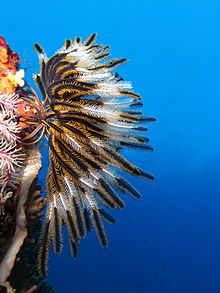

This article needs additional citations for verification. Please help improve this articlebyadding citations to reliable sources. Unsourced material may be challenged and removed.
Find sources: "Crinozoa" – news · newspapers · books · scholar · JSTOR (August 2023) (Learn how and when to remove this message) |
| Crinozoa
| |
|---|---|

| |
| Crinoid on the reef of Batu Moncho Island, Indonesia | |
| Scientific classification | |
| Domain: | Eukaryota |
| Kingdom: | Animalia |
| Phylum: | Echinodermata |
| Subphylum: | Crinozoa Matsumoto 1929 |
| Classes | |
| |
Crinozoa is a subphylum of mostly sessile echinoderms, of which the crinoids, or sea lilies and feather stars, are the only extant members.[1][2] Crinozoans have an extremely extensive fossil history, which may or may not extend into the Precambrian (provided the enigmatic Ediacaran Arkarua can be positively identified as an edrioasteroid).
The classes currently contained within Crinozoa include Crinoidea and the extinct Paracrinoidea (Cystoidea, Edrioasteroidea, and Rhombifera).[2]
Since the Paleozoic, sea lilies, or crinoids, have been able to regenerate and undergo arm autotomy or the intentional amputation of a limb. The sea lily can regenerate all of its arms at once in addition to its entire crown. Their stalk's uppermost segment and the basal plates have the capacity to regenerate the entire crown. Nutrients and other components from the stalk, especially the upper 5 cm, are used by crown regeneration.[3]
| Crinozoa |
|
|---|---|
This echinoderm-related article is a stub. You can help Wikipedia by expanding it. |